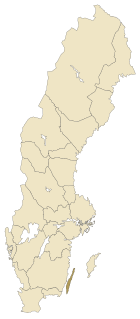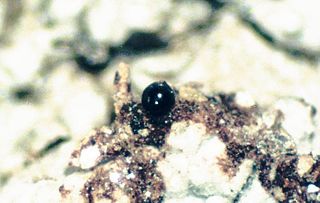
An alvar is a biological environment based on a limestone plain with thin or no soil and, as a result, sparse grassland vegetation. Often flooded in the spring, and affected by drought in midsummer, alvars support a distinctive group of prairie-like plants. Most alvars occur either in northern Europe or around the Great Lakes in North America. This stressed habitat supports a community of rare plants and animals, including species more commonly found on prairie grasslands. Lichen and mosses are common species. Trees and bushes are absent or severely stunted.
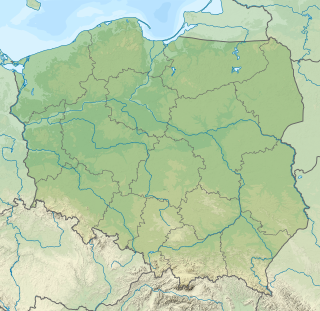
UNESCO Biosphere Reserves are environment-protected scientific-research institutions of international status that are created with the intent for conservation in a natural state the most typical natural complexes of biosphere, conducting background ecological monitoring, studying of the surrounding natural environment, its changes under the activity of anthropogenic factors.

Lilla Karlsö is a small Swedish island in the Baltic Sea, situated about 3 km (1.9 mi) off the west coast of Gotland and 4.5 km (2.8 mi) from Stora Karlsö; it is part of Eksta socken. It has an area of about 1.6 km2 (0.62 sq mi) and is 66 m (217 ft) high. Most of the island consists of a limestone plateau. Parts of the shoreline is bordered by steep cliffs. The island is mostly covered by alvar. There is also some very old broadleaf forest, which is unique for Gotland. There are several caves and up to 16 m (52 ft) high limestone pillars.
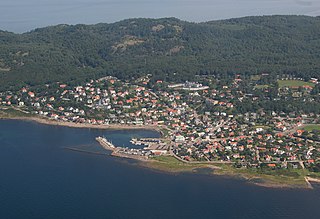
Mölle is a locality situated in Höganäs Municipality, Skåne County, Sweden with 715 inhabitants in 2010.
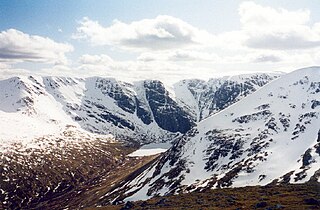
Creag Meagaidh is a mountain on the northern side of Glen Spean in the Highlands of Scotland. It is a complex mountain, taking the form of a flat summit plateau from which five ridges radiate, and is most famed for the cliffs surrounding the corrie of Coire Ardair on the north-eastern face. These crags are a renowned venue for winter and ice climbing, although being somewhat vegetated they are less suited to summer climbing.
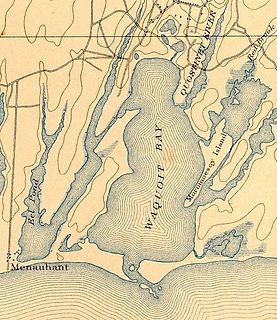
Waquoit Bay is a public national estuary, which is typically used as a research reserve. It is a part of Nantucket Sound and is located on the southern shore of Cape Cod in Massachusetts, USA. This bay forms the border of the towns of Falmouth, Massachusetts and Mashpee.

Kullaberg is a peninsula and nature reserve of land protruding into the Kattegat in Höganäs Municipality near the town of Mölle in southwest Sweden. The site in the province of Skåne is an area of considerable biodiversity supporting a number of rare species and has been designated as an Important Bird Area (IBA) in Sweden as well as a Special Protection Area (SPA). The terrain is dominated by steep cliffs rising from the sea and rocky outcrops on the ridge above, the highest elevation being Mount Håkull at 188 meters. Ridgetop vegetation includes a mixed hardwood broadleaf forest consisting of birch, beech, oak and pine trees with an understory of hawthorn, juniper, wild honeysuckle and blackthorn. Among the notable rare plants are spring vetchling, Lathyrus sphaericus.
State Reserves of Azerbaijan refers to the state reserves in Azerbaijan, which preserve the fauna, flora and their ecosystems.

Alby is a village on the Baltic Sea in the Hulterstad district at the western fringe of the Stora Alvaret on the island of Öland, Sweden.

Dwarf forest, elfin forest, or pygmy forest is a rare ecosystem featuring miniature trees, inhabited by small species of fauna such as rodents and lizards. They are usually located at high elevations, under conditions of sufficient air humidity but poor soil. There are two main dwarf forest ecosystem types, involving different species and environmental characteristics: coastal temperate and montane tropical regions. Temperate coastal dwarf forest is common for parts of Southern California. Montane tropical forests are found across tropical highlands of Central America, northern South America and Southeast Asia. There are also other isolated examples of dwarf forests scattered across the world.

Flemingsbergsskogen Nature Reserve is a nature reserve in Huddinge Municipality south of central Stockholm, Sweden.
Wasque ("way-squee") or Wasque Beach is a 200-acre (0.81 km2) nature reserve on Chappaquiddick Island, Martha's Vineyard, Massachusetts. The site was established as a reservation for the public in 1967 and is one of five conservation areas on "the Vineyard" managed by the Trustees of Reservations. Wasque contains a sandy strand the Boston Globe calls "a magnificent beach." Travel + Leisure named Wasque Beach the number one beach in New England and WHDH-TV reports "It's pristine, serene, and rain or shine, it's a beach-goers' delight." Off the shore of Wasque Beach is Katama Bay, "a vast and pristine salt water bay that includes many acres of productive shellfish beds."

Särö Västerskog is a nature reserve located in Kungsbacka Municipality, Sweden, on a peninsula west of the locality of Särö. It was established in 1974 and is currently part of the Natura 2000 ecological network.
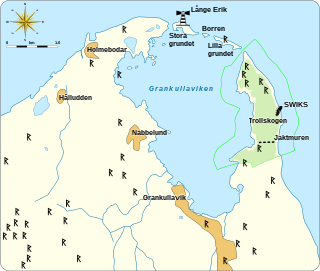
Grankullaviken is a shallow bay at the northern tip of Öland, Sweden, located in Böda socken, Borgholm Municipality. The bay is almost completely enclosed by two headlands and a few small shoal islands. Grankullavik is also the name of a village on the bay. The lighthouse Långe Erik on the Stora grundet island is officially named Ölands norra udde, even though the western headland extends a bit further north than the island upon which it stands. The eastern headland is the site of the windswept forest and nature reserve Trollskogen.

Nabbelund is a village in Böda socken, in the Borgholm Municipality of Öland, Sweden. Located on the western shore of the Grankullaviken bay, just south of the lighthouse Långe Erik and north of the village Grankullavik, it was formerly an important shipping port for timber.

Böda kronopark is a Kronopark and currently an Ekopark on Öland, Sweden, north of the village of Böda. It has 6000 hectares of mainly coniferous forest and takes up most of the northern part of Öland, except for the northwestern tip. Its eastern boundary is the Baltic Sea, with a ten-kilometer long sandy beach. The park was a royal hunting domain and then became part of the Domänverket. In 2006 the park became an Ekopark, meaning a park run by a forestry company, comparable to a nature reserve but with fewer regulations and allowing for the harvesting of lumber.

Byrum's raukar are a geological formation of a group of stacks on the western shore in the north of Öland, Sweden near the village of Byrum. The group consists of about 120 limestone stacks, rich in fossils, of up to 4 m (13 ft) high on a 600 m (2,000 ft) stretch of beach. The area is about 3 hectares, is a Natural Monument III and a nature reserve since 1935.
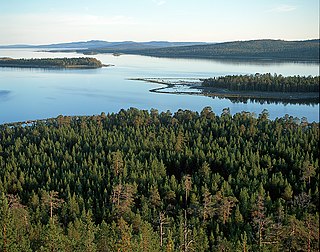
Kandalaksha Nature Reserve is a Russian 'zapovednik' on the south shore of Kandalaksha Bay in the Murmansk and Karelia regions on the opening to the White Sea. The reserve also includes two small sectors on the northern coast of the Kola peninsula on the Barents Sea; notably, the warm Atlantic current causes the northern sectors on the Barents Sea to be warmer than the more southerly White Sea sectors. Over 550 islands are covered in the boundaries of the reserve. It is one of the oldest nature reserves in Russia, created in 1932 to protect the marine habitats and waterfowl of the region, particularly the eider. The reserve is situated in the Kandalakshsky District, Kolsky District, and Lovozersky District of Murmansk Oblast. The nearest city, Kandalaksha, is at the northwest entrance to the Kandalaksha Gulf, about 5 km from the nearest point in the reserve. Since 1976, the reserve has been part of the RAMSAR wetland site of international importance "Kandalaksha Bay". It covers an area of 70,530 ha (272.3 sq mi).




